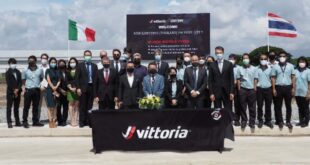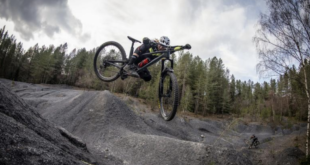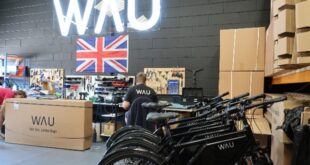It’s highly unlikely you will have heard of Keronite before its introduction into the bicycle market in the early months of 2011. That is unless you work for a Forumla One race team, are a NASA engineer, or have a particular penchant for the gear boxes on helicopters. The technology was, in fact, born out of the Russian space programme with scientists seeking a long wearing, flexible and heat dissipating coat for components destined to be launched skywards.
You may, however, have stared right at Keronite product and been none the wiser. Go Cycle, for example, has its magnesium frames coated by Keronite, which is then covered over with a powder coat.
Perhaps you’ve observed yacht racing. At BikeBiz, we’re certainly no experts, but we’re told that during a race, non-Keronite coated masts typically should have a rope wrapped around up to four times, costing valuable time. Keronite coated masts cut the time spent here by half, offering performance advantages over the competition. This is thanks to the material’s adhesive properties.
So, what is Keronite? In layman’s terms, it’s a ductile ceramic style coating, but far deeper ingrained in the base material, to the point where it atomically bonds by a few microns making it inseparable from its host. Of course it’s much more technical than that, involving plasma, electrical charges and a lot of sciency stuff better explained by the firm’s research and development partners at Cambridge University.
Mavic calls the tech ‘Exalith’ on its 2011 product, for which four aluminium rims have received the special treatment at Keronite’s Bicester plant – the Comete Road, Cosmic Carbone SLR, R-Sys SLR and Ksyrium SLR.
Alex Coventry, the UK sales manager for Mavic told BikeBiz: "We’ve actually been working with Keronite for around four years now. In that time packing in a year of solid machine and on bike testing with a team of 11 athletes. These guys put the wheels through six straight weeks of 100-mile per day rides up and down mountains, through rain and fairer conditions and have been unable to fault the Keronite surface, particularly given the braking advantages."
Those advantages are revealed particularly in wet conditions where Coventry reveals: "a Keronite-coated rim will stop a bike better when wet than an aluminium rim in the dry." For this reason, as well as the aesthetic advantages, Mavic has exclusivity for Keronite coating rims worldwide.
There are many other advantages to ‘Keroniting’ a surface too. Compared to anodising a surface, which by creating minute cracks in the surface gives such products a slightly lower fatigue strength, Keronite’s coat is more consistent.
On a standard aluminium rim, Coventry says wear life will be extended by between 20 and 30 per cent dependant on conditions. "Your wheel will give in long before the Keronite surface shows signs of wear," he adds. Road salts and chemicals are well resisted by the coat, with tested rims lasting a cycle of 2,000 hours of salt spray without any major damage. Thanks to the 25-micron thickness of the coat, heat is dissipated under heavy braking very quickly, too.
Now for the sales winner, it’s lighter than anodizing and similar processes. Rock Shox saved 30 grams on its 2011 Boxxer fork legs, which neglect the usual painting methods, introducing Keronite in a grey shade.
The future is Kero-bright
The colour, though in the grand scheme of things barely worth mentioning, may perhaps be a stumbling block to some firms’ interest in this wonder coat. To date, Keronite has only managed unique shades of black, grey and white from its process. It can however, be painted over, though this would negate the weight saving and scuff resistance advantages.
Mavic, alongside Swiss Stop, have Keronite specific brake pads which make the most of the adhesive properties of the coat. Each of the four models carrying the tech are supplied with a set of these ‘Exalith’ pads, as well as a tube and tyre. Replacement ‘Exalith’ pads will retail at £40, roughly the same as performance brake pads for many carbon rims.
Prototype product from other cycling manufacturers was spotted by BikeBiz on the visit to Keronite HQ, indicating the industry has taken note. Crank arms, stems and chainring spiders were present during BikeBiz’s HQ visit. However, with the former perhaps making the most sense in terms of resistance to colour disparity so often seen on the painted arm of many cranks.
Mavic confirmed to BikeBiz that it will soon roll out its Keronite programme into other areas for which it produces hard goods. Meanwhile, Keronite’s UK production line is working overtime, coating rims at a rate of 16 per hour. This however, seems like it may just be the beginning for the business the firm does with cycle trade partners.
Why use Keronite surface treatment?
- It’s ductile
Much thanks to the atomic bonding process, the ‘coat’ is as flexible as the object it is bonded to.
- It’s lighter and wear life is longer
Lighter than other methods such as anodising anyway. At only 25 microns thick, weight added is negligible. The surface lasts “20 to 30 per cent longer” than aluminium rims.
- It has a higher fatigue strength
Higher than anodising anyway, largely down to the ‘cracks’ created via anodising. Keronite is more consitant.
- It’s smooth, yet adhesive
Just look at Mavic’s rims, smooth, yet when a ‘Exalith pad is applied’, that wheel is stopping thanks to the adhesive properties.
- The industry has taken note
Rock Shox, Mavic, Go Cycle and others now work with Keronite.
- Better braking in the wet
Mavic was so taken aback by Keronite’s stopping power in the wet, it made sure the business had worldwide exclusivity for rims.
- It’s atomically bonded and eco-friendly
Keronite bonds with the sub-structure by a few microns. There is no waste product.
- Supporting a UK business
Though there are other facilites outside Bicester and Cambridge, the patent to Keronite is owned by a UK firm.
- Chemical resistance
2,000 hours of continuous salt spray couldn’t break a Keronite surface.
 BikeBiz Bicycle and cycling retail news
BikeBiz Bicycle and cycling retail news



